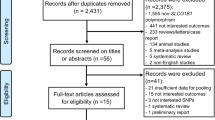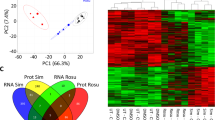Abstract
High cholesterol levels are an established risk factor for cardiovascular disease (CVD), the world's leading cause of death. Inhibitors of 3-hydroxy-3-methylglutaryl-coenzyme A reductase (statins) are prescribed to lower serum cholesterol levels and reduce the risk of CVD. Despite the success of statins, many patients abandon treatment owing to neuromuscular adverse drug reactions (ADRs). Genome-wide association studies have identified the single-nucleotide polymorphism (SNP) rs4149056 in the SLCO1B1 gene as being associated with an increased risk for statin-induced ADRs. By studying slow-channel syndrome transgenic mouse models, we determined that statins trigger ADRs in mice expressing the mutant allele of the rs137852808 SNP in the nicotinic acetylcholine receptor (nAChR) α-subunit gene CHRNA1. Mice expressing this allele show a remarkable contamination of end-plates with caveolin-1 and develop early signs of neuromuscular degeneration upon statin treatment. This study demonstrates that genes coding for nAChR subunits may contain variants associated with statin-induced ADRs.
This is a preview of subscription content, access via your institution
Access options
Subscribe to this journal
Receive 6 print issues and online access
$259.00 per year
only $43.17 per issue
Buy this article
- Purchase on Springer Link
- Instant access to full article PDF
Prices may be subject to local taxes which are calculated during checkout





Similar content being viewed by others
References
Kannel WB, Dawber TR, Kagan A, Revotskie N, Stokes III J . Factors of risk in the development of coronary heart disease—six year follow-up experience. The Framingham Study. Ann Intern Med 1961; 55: 33–50.
Roger VL, Go AS, Lloyd-Jones DM, Adams RJ, Berry JD, Brown TM et al. Heart disease and stroke statistics—2011 update: a report from the American Heart Association. Circulation 2011; 123: e18–209.
Brautbar A, Ballantyne CM . Pharmacological strategies for lowering LDL cholesterol: statins and beyond. Nat Rev Cardiol 2011; 8: 253–265.
Baigent C, Keech A, Kearney PM, Blackwell L, Buck G, Pollicino C et al. Efficacy and safety of cholesterol-lowering treatment: prospective meta-analysis of data from 90 056 participants in 14 randomised trials of statins. Lancet 2005; 366: 1267–1278.
Haukka J, Niskanen L, Partonen T, Lönnqvist J, Tiihonen J . Statin usage and all-cause and disease-specific mortality in a nationwide study. Pharmacoepidemiology and Drug Safety 2012; 21: 61–69.
Fernandez G, Spatz ES, Jablecki C, Phillips PS . Statin myopathy: a common dilemma not reflected in clinical trials. Cleve Clin J Med 2011; 78: 393–403.
Tomaszewski M, Stêpieñ KM, Tomaszewska J, Czuczwar SJ . Statin-induced myopathies. Pharmacol Rep 2011; 63: 859–866.
Staffa JA, Chang J, Green L . Cerivastatin and reports of fatal rhabdomyolysis. N Engl J Med 2002; 346: 539–540.
Vladutiu GD . Genetic predisposition to statin myopathy. Curr Opin Rheumatol 2008; 20: 648–655.
Mangravite LM, Thorn CF, Krauss RM . Clinical implications of pharmacogenomics of statin treatment. Pharmacogenomics J 2006; 6: 360–374.
Link E, Parish S, Armitage J, Bowman L, Heath S, Matsuda F et al. SLCO1B1 variants and statin-induced myopathy—a genomewide study. N Engl J Med 2008; 359: 789–799.
Ruaño G, Thompson PD, Windemuth A, Seip RL, Dande A, Sorokin A et al. Physiogenomic association of statin-related myalgia to serotonin receptors. Muscle Nerve 2007; 36: 329–335.
Ruaño G, Thompson PD, Windemuth A, Smith A, Kocherla M, Holford TR et al. Physiogenomic analysis links serum creatine kinase activities during statin therapy to vascular smooth muscle homeostasis. Pharmacogenomics 2005; 6: 865–872.
Brunham LR, Lansberg PJ, Zhang L, Miao F, Carter C, Hovingh GK et al. Differential effect of the rs4149056 variant in SLCO1B1 on myopathy associated with simvastatin and atorvastatin. The Pharmacogenomics J advance online publication, 18 January 2011; doi:10.1038/tpj.2010.92.
Marciante KD, Durda JP, Heckbert SR, Lumley T, Rice K, McKnight B et al. Cerivastatin, genetic variants, and the risk of rhabomyolysis. Pharmacogenet Genomics 2011; 21: 280–288.
Karlin A . Emerging structure of the nicotinic acetylcholine receptors. Nat Rev Neurosci 2002; 3: 102–114.
Corringer PJ, Le Novère N, Changeux JP . Nicotinic receptors at the amino acid level. Annu Rev Pharmacol Toxicol 2000; 40: 431–458.
Le Novère N, Corringer P-J, Changeux J-P . The diversity of subunit composition in nAChRs: evolutionary origins, physiologic and pharmacologic consequences. J Neurobiol 2002; 53: 447–456.
Engel AG, Shen X-M, Selcen D, Sine SM . What have we learned from the congenital myasthenic syndromes. J Mol Neurosci 2010; 40: 143–153.
Otero-Cruz JD, Báez-Pagán CA, Dorna-Pérez L, Grajales-Reyes GE, Ramírez-Ordoñez RT, Luciano CA et al. Decoding pathogenesis of slow-channel congenital myasthenic syndromes using recombinant expression and mice models. P R Health Sci J 2010; 29: 4–17.
Burger K, Gimpl G, Fahrenholz F . Regulation of receptor function by cholesterol. Cell Mol Life Sci 2000; 57: 1577–1592.
Fong TM, McNamee MG . Correlation between acetylcholine receptor function and structural properties of membranes. Biochemistry 1986; 25: 830–840.
Guzmán GM, Ortiz-Acevedo A, Santiago J, Rojas LV, Lasalde-Dominicci JA . Regulation of acetylcholine receptor function by cholesterol. In: Recent Res Devel Membrane Biol. Research Signpost: India, 2002, pp 127–146.
Santiago J, Guzmàn GR, Rojas LV, Marti R, Asmar-Rovira GA, Santana LF et al. Probing the effects of membrane cholesterol in the Torpedo californica acetylcholine receptor and the novel lipid-exposed mutation alpha C418W in Xenopus oocytes. J Biol Chem 2001; 276: 46523–46532.
Gomez CM, Maselli R, Gundeck JE, Chao M, Day JW, Tamamizu S et al. Slow-channel transgenic mice: a model of postsynaptic organellar degeneration at the neuromuscular junction. J Neurosci 1997; 17: 4170–4179.
Gomez CM, Maselli RA, Groshong J, Zayas R, Wollmann RL, Cens T et al. Active calcium accumulation underlies severe weakness in a panel of mice with slow-channel syndrome. J Neurosci 2002; 22: 6447–6457.
Vohra BPS, Groshong JS, Maselli RA, Verity MA, Wollmann RL, Gomez CM . Focal caspase activation underlies the endplate myopathy in slow-channel syndrome. Ann Neurol 2004; 55: 347–352.
Vohra BPS, Groshong JS, Zayas R, Wollmann RL, Gomez CM . Activation of apoptotic pathways at muscle fiber synapses is circumscribed and reversible in a slow-channel syndrome model. Neurobiol Dis 2006; 23: 462–470.
Groshong JS, Spencer MJ, Bhattacharyya BJ, Kudryashova E, Vohra BPS, Zayas R et al. Calpain activation impairs neuromuscular transmission in a mouse model of the slow-channel myasthenic syndrome. J Clin Invest 2007; 117: 2903–2912.
Báez-Pagán CA, Martínez-Ortiz Y, Otero-Cruz JD, Salgado-Villanueva IK, Velázquez G, Ortiz-Acevedo A et al. Potential role of caveolin-1-positive domains in the regulation of the acetylcholine receptor's activatable pool: implications in the pathogenesis of a novel congenital myasthenic syndrome. Channels (Austin) 2008; 2: 180–190.
Lardizabal JA, Deedwania PC . Benefits of statin therapy and compliance in high risk cardiovascular patients. Vasc Health Risk Manag 2010; 6: 843–853.
Jacobson TA . Toward ‘pain-free’ statin prescribing: clinical algorithm for diagnosis and management of myalgia. Mayo Clin Proc 2008; 83: 687–700.
Altshuler D, Daly MJ, Lander ES . Genetic mapping in human disease. Science 2008; 322: 881–888.
Hirschhorn JN, Gajdos ZKZ . Genome-wide association studies: results from the first few years and potential implications for clinical medicine. Annu Rev Med 2011; 62: 11–24.
Cannon TD . Candidate gene studies in the GWAS era: the MET proto-oncogene, neurocognition, and schizophrenia. Am J Psychiatry 2010; 167: 369–372.
Amos W, Driscoll E, Hoffman JI . Candidate genes versus genome-wide associations: which are better for detecting genetic susceptibility to infectious disease? Proc Biol Sci 2011; 278: 1183–1188.
Johansen CT, Wang J, Lanktree MB, Cao H, McIntyre AD, Ban MR et al. Excess of rare variants in genes identified by genome-wide association study of hypertriglyceridemia. Nat Genet 2010; 42: 684–687.
Kwon JM, Goate AM . The candidate gene approach. Alcohol Res Health 2000; 24: 164–168.
Couvert P, Chapman MJ, Carrié A . Impact of genetic variation in the SLCO1B1 gene on statin efficacy in low-density lipoprotein cholesterol-lowering therapy. Pharmacogenomics 2011; 12: 137–139.
Voora D, Shah SH, Spasojevic I, Ali S, Reed CR, Salisbury BA et al. The SLCO1B1*5 genetic variant is associated with statin-induced side effects. J Am Coll Cardiol 2009; 54: 1609–1616.
Gomez CM, Bhattacharyya BB, Charnet P, Day JW, Labarca C, Wollmann RL et al. A transgenic mouse model of the slow-channel syndrome. Muscle Nerve 1996; 19: 79–87.
Williams TM, Lisanti MP . The caveolin proteins. Genome Biol 2004; 5: 214.
Lajoie P, Nabi IR . Lipid rafts, caveolae, and their endocytosis. Int Rev Cell Mol Biol 2010; 282: 135–163.
Murata M, Peränen J, Schreiner R, Wieland F, Kurzchalia TV, Simons K . VIP21/caveolin is a cholesterol-binding protein. Proc Natl Acad Sci USA 1995; 92: 10339–10343.
Chang WJ, Rothberg KG, Kamen BA, Anderson RG . Lowering the cholesterol content of MA104 cells inhibits receptor-mediated transport of folate. J Cell Biol 1992; 118: 63–69.
Shen X-M, Deymeer F, Sine SM, Engel AG . Slow-channel mutation in acetylcholine receptor alphaM4 domain and its efficient knockdown. Ann Neurol 2006; 60: 128–136.
Meador BM, Huey KA . Statin-associated myopathy and its exacerbation with exercise. Muscle Nerve 2010; 42: 469–479.
Acknowledgements
This work was supported in part by National Institutes of Health (NIH) grants 2R01GM56371-12 and SNRP U54NS0430311 to J.A. Lasalde-Dominicci and NIH grant R01NS033202 to C. Gómez. We acknowledge the contribution to this study by grants ISI0 RR-13705-01 and DBI-0923132 to establish and upgrade the Confocal Microscopy Facility at the University of Puerto Rico (CIF-UPR). G. Grajales-Reyes, J.G. Grajales-Reyes, and W.F. García-Beltrán were supported by the Research Initiative for Scientific Enhancement (RISE) Program Grant R25GM61151 and the Minority Access to Research Careers (MARC) Program Grant T34GM007821. M. Delgado-Vélez was supported by the Research Initiative for Scientific Enhancement (RISE) Program Grant R25GM61151 and the PR-LSAMP Program Grant HRD0601843. We thank Andrew Loza for his excellent assistance with the MATLAB heat map analysis.
Author information
Authors and Affiliations
Corresponding authors
Ethics declarations
Competing interests
GEGR, CABP, CAL, OQ and JALD have filed a provisional patent application for materials related to this manuscript. Myo ADR Technologies, Corp. was founded by CABP, CAL, OQ and JALD to commercialize intellectual property published in this manuscript.
Additional information
Supplementary Information accompanies the paper on The Pharmacogenomics Journal website
Supplementary information
Rights and permissions
About this article
Cite this article
Grajales-Reyes, G., Báez-Pagán, C., Zhu, H. et al. Transgenic mouse model reveals an unsuspected role of the acetylcholine receptor in statin-induced neuromuscular adverse drug reactions. Pharmacogenomics J 13, 362–368 (2013). https://doi.org/10.1038/tpj.2012.21
Received:
Revised:
Accepted:
Published:
Issue Date:
DOI: https://doi.org/10.1038/tpj.2012.21
Keywords
This article is cited by
-
The alpha7-nicotinic receptor contributes to gp120-induced neurotoxicity: implications in HIV-associated neurocognitive disorders
Scientific Reports (2018)
-
Heterogeneous Inhibition in Macroscopic Current Responses of Four Nicotinic Acetylcholine Receptor Subtypes by Cholesterol Enrichment
The Journal of Membrane Biology (2016)
-
Interaction between rosuvastatin and rocuronium in rat sciatic-gastrocnemius nerve-muscle preparation
Journal of Anesthesia (2014)



